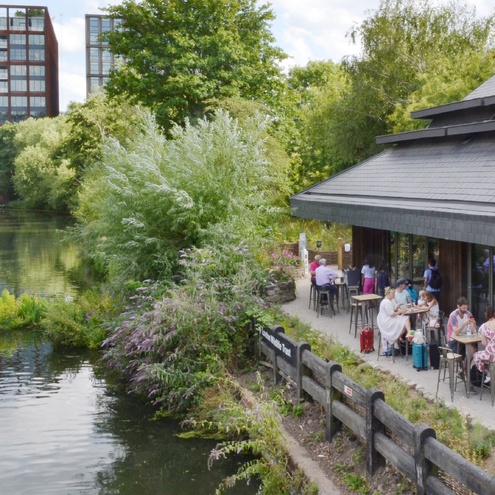Get updates from The Developer straight to your inbox Yes, please!
Camley Street Natural Park, Camden – London Wildlife Trust with Erect Architecture and HTA Design

In the middle of the King’s Cross regeneration area and on the bank of Regent’s canal, Camley Street Natural Park offers a wildlife oasis for those that work in the city. Improvements to pond access and paths, a floating viewpoint and a number of volunteering programmes and educational opportunities contribute to the London Wildlife Trust’s commitment to urban outdoor learning.
Who is on the project team?
Architect: Erect Architecture
Landscape Architect: LUC
Structural Engineer: TALL / Entuitive
Project Manager, Quantity Surveyor: Huntley Cartwright
Environmental & Building Services Engineer: Ritchie+Daffin
Main contractor: Ash Contracting
Describe the context of this project and its neighbourhood and people?
Camley Street Natural Park sits within the Regent’s Canal Conservation Area, located in the middle of the King’s Cross regeneration area. Various build-over attempts of the former coal drop, overgrown after disuse, were thwarted by strong local community campaigns since the 1980s. It’s now a designated Site of Importance for Nature Conservation and a statutory Local Nature Reserve, a green oasis of calm. The London Wildlife Trust has managed CSNP since 1983. It has long been a valued resource for the local community and visitors from further afield looking to spend time in a unique urban nature reserve.
The community surrounding CSNP has changed radically in 30 years and the reserve is now at the heart of the largest urban redevelopment in Europe with institutions like Central St Martin’s and the Francis Crick Institute, and global businesses like Google within 1km.
Tell us what you did and how the project enlivened the place?
The reserve has a history of improvements to increase biodiversity and visitor numbers (a careful balancing act). The recent National Lottery Heritage Funded phase was the most significant push by the London Wildlife Trust to improve the nature reserve, expand community activities and create revenue. It reconfigured the northern end of the reserve in response to a new bridge, created an open-air event space and included a new visitor and learning centre. Landscape changes and improvements were delivered by the contractor and volunteers. The ‘gatehouse’ building accommodates educational events in a fluid indoor/outdoor setting, supporting the Trust’s learning programme and nature conservation volunteers. It provides revenue through event lettings and café sales.
The low carbon, passive building is a nod to the past use of the site as a Victorian coal drop and incorporates wildlife habitats and sustainability features. The northern space has direct access to the canal and can accommodate a large marquee rigged against the building for additional event capacity, keeping the building footprint lean. Large covered outdoor spaces with handwash basins enable hands-on outdoor activities. The project’s greatest success is its positive social impact and increased access to nature for inner city dwellers. Improvements delivered through the project have led to a wider offer of learning activities, greater accessibility and increased biodiversity and habitats. This has resulted in higher visitor numbers: more people immersing themselves in nature (and all its wellbeing benefits) and the broad range of opportunities for learning, relaxation and socialising created by the space.
Did the project make a positive social and environmental contribution?
London Wildlife Trust’s programme welcomes all members of the community to access nature and benefit from time spent in local green space. The new building and improved reserve enable the Trust to continue to inspire Londoners through nature and deliver well-established programmes including schools learning, family learning and practical conservation volunteering. Additional activities offered through the Trust’s Keeping It Wild youth engagement programme include ‘Nature Nurtures’ creative youth volunteering taster sessions and partnership work with Flock Together, a birdwatching collective for people of colour. Indoor spaces are regularly used for events including wildlife drawing and yoga.
The space has enabled the Trust to reach out to local communities under-represented in their access to green space, introducing them to the site and engaging through bespoke activities to ensure they are aware of the nature reserve and feel able to visit independently. This includes local community centres and children’s centres, women’s groups, refugee groups and groups focussed on mental and physical wellbeing. Improvements were made to the ponds access path and paths around the site.
The meadow area was improved and enlarged alongside the new accessible path and new floating wetland habitat islands were installed in the Regent’s canal, increasing the range of fully accessible experiences. A generous area around the building is fully accessible to enable those not able or wanting to travel far to experience different site conditions: the canal, the meadow wetlands, the woods. New signage and interpretation help people to learn about the reserve’s natural and industrial heritage.
Since reopening to the public in October 2021, over 159,000 people have visited the centre to enjoy the new café, nature reserve and events on site. In its first year, the site’s learning programme engaged 5,675 people of all ages, including 2,553 school pupils who attended curriculum-linked sessions. Regular family drop-in days and holiday activity days have engaged a further 3,122 visitors through activities such as pond dipping, minibeast hunting, nature crafts and bird walks.
Sign up to our newsletter
Get updates from The Developer straight to your inbox
Thanks to our organisation members
© Festival of Place - Tweak Ltd., 124 City Road, London, EC1V 2NX. Tel: 020 3326 7238